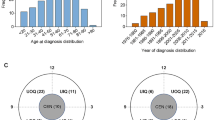Abstract
Secretory breast carcinoma represents a rare subtype within basal-like tumours of the breast, having an excellent prognosis, in stark contrast with other basal-like tumours. These tumours are typically ER, PR and HER-2 negative, and S-100 positive. Recurrences are far and few, and treatment is predominantly surgical. We report here a unique case of S-100 marker-negative secretory breast carcinoma in an adult female with a clinical presentation and histo-morphological features otherwise typical of secretory breast carcinomas. This case was managed with radical surgery and adjuvant chemotherapy. Secretory breast carcinomas are unique among basal-like tumours in having an excellent prognosis. They may however be part of a larger spectrum of secretory carcinomas across several glandular organs, with the recently discovered ETV6-NTRK3 fusion gene as a common, recurring mutation. The significance of absence of S-100 staining is not yet clear; however, it may portend a worse prognosis, warranting more aggressive therapy.





Similar content being viewed by others
References
Tavassoli FA (2003) Secretory carcinoma. Pathology and genetics of tumors of the breast and female genital organs. World Health Organ Classif Tumours 4:42–3
McDivitt RW, Stewart FW (1966) Breast carcinoma in children. JAMA 195(5):388–390
Oberman HA (1980) Secretory carcinoma of the breast in adults. Am J Surg Pathol 4(5):465–470
Tavassoli FA, Norris HJ (1980) Secretory carcinoma of the breast. Cancer 45(9):2404–2413
Rosen PP, Cranor ML (1991) Secretory carcinoma of the breast. Arch Pathol Lab Med 115(2):141
Maitra A, Tavassoli FA, Albores-Saavedra J, Behrens C, Wistuba II, Bryant D, Weinberg AG, Rogers BB, Saboorian MH, Gazdar AF (1999) Molecular abnormalities associated with secretory carcinomas of the breast. Hum Pathol 30(12):1435–1440
Laé M, Fréneaux P, Sastre-Garau X, Chouchane O, Sigal-Zafrani B, Vincent-Salomon A (2009) Secretory breast carcinomas with ETV6-NTRK3 fusion gene belong to the basal-like carcinoma spectrum. Mod Pathol 22(2):291–298
Lambros MB, Tan DS, Jones RL, Vatcheva R, Savage K, Tamber N, Fenwick K, Mackay A, Ashworth A, Reis-Filho JS (2009) Genomic profile of a secretory breast cancer with an ETV6–NTRK3 duplication. J Clin Pathol 62(7):604–612
Hirokawa M, Sugihara K, Sai T, Monobe Y, Kudo H, Sano N, Sano T (2002) Secretory carcinoma of the breast: a tumour analogous to salivary gland acinic cell carcinoma? Histopathology 40(3):223–229
Tognon C, Garnett M, Kenward E, Kay R, Morrison K, Sorensen PH (2001) The chimeric protein tyrosine kinase ETV6-NTRK3 requires both Ras-Erk1/2 and PI3-kinase-Akt signalling for fibroblast transformation. Can Res 61(24):8909–8916
Strauss BL, Bratthauer GL, Tavassoli FA (2006) STAT 5a expression in the breast is maintained in secretory carcinoma, in contrast to other histologic types. Hum Pathol 37(5):586–592
Skálová A, Vanecek T, Sima R, Laco J, Weinreb I, Perez-Ordonez B, Starek I, Geierova M, Simpson RH, Passador-Santos F, Ryska A (2010) Mammary analogue secretory carcinoma of salivary glands, containing the ETV6-NTRK3 fusion gene: a hitherto undescribed salivary gland tumor entity. Am J Surg Pathol 34(5):599–608
Dogan S, Wang L, Ptashkin RN, Dawson RR, Shah JP, Sherman EJ, Tuttle RM, Fagin JA, Klimstra DS, Katabi N, Ghossein RA (2016) Mammary analog secretory carcinoma of the thyroid gland: a primary thyroid adenocarcinoma harboring ETV6–NTRK3 fusion. Mod Pathol 29(9):985–995
Bishop JA, Yonescu R, Batista D, Eisele DW, Westra WH (2013) Most non-parotid “acinic cell carcinomas” represent mammary analogue secretory carcinomas. Am J Surg Pathol 37(7):1053
Bourgeois JM, Knezevich SR, Mathers JA, Sorensen PH (2000) Molecular detection of the ETV6-NTRK3 gene fusion differentiates congenital fibrosarcoma from other childhood spindle cell tumors. Am J Surg Pathol 24(7):937–946
Lamovec J, Bracko M (1994) Secretory carcinoma of the breast: light microscopical, immunohistochemical and flow cytometric study. Mod Pathol: an official journal of the United States and Canadian Academy of Pathology, Inc. 7(4):475
Ito S, Ishida E, Skalova A, Matsuura K, Kumamoto H, Sato I (2012) Case report of mammary analog secretory carcinoma of the parotid gland. Pathol Int 62(2):149–152
Coppola D, Fu L, Nicosia SV, Kounelis S, Jones M (1998) Prognostic significance of p53, bcl-2, vimentin, and S 100 protein-positive langerhans cells in endometrial carcinoma. Hum Pathol 29(5):455–462
Oka K, Nakano T, Arai T (1992) Adenocarcinoma of the cervix treated with radiation alone: prognostic significance of S-100 protein and vimentin immunostaining. Obstet Gynecol 79(3):347–350
Giannini A, Bianchi S, Messerini L, Gallo O, Gallina E, Libonati GA, Olmi P, Zampi G (1991) Prognostic significance of accessory cells and lymphocytes in nasopharyngeal carcinoma. Pathol Res Pract 187(4):496–502
Andrés R, Mayordomo JI, Visus C, Isla D, Godino J, Escudero P, Saenz A, Ortega E, Lastra R, Lambea J, Aguirre E (2008) Prognostic significance and diagnostic value of protein S-100 and tyrosinase in patients with malignant melanoma. Am J Clin Oncol 31(4):335–339
Richard G, Hawk JC III, Baker AS Jr, Austin RM (1990) Multicentric adult secretory breast carcinoma: DNA flow cytometric findings, prognostic features, and review of the world literature. J Surg Oncol 44(4):238–244
Vieni S, Cabibi D, Cipolla C, Fricano S, Graceffa G, Latteri MA (2006) Secretory breast carcinoma with metastatic sentinel lymph node. World J Surg Oncol 4(1):1–7
Author information
Authors and Affiliations
Corresponding author
Ethics declarations
Conflict of Interest
The authors declare no competing interests.
Additional information
Publisher's Note
Springer Nature remains neutral with regard to jurisdictional claims in published maps and institutional affiliations.
Rights and permissions
About this article
Cite this article
Rao, S.A., Suresh, S., Imtiyaz, K. et al. S-100 Protein-Negative Secretory Breast Carcinoma: Case Report of a Rare Entity. Indian J Surg 84, 1315–1319 (2022). https://doi.org/10.1007/s12262-021-03218-x
Received:
Accepted:
Published:
Issue Date:
DOI: https://doi.org/10.1007/s12262-021-03218-x




